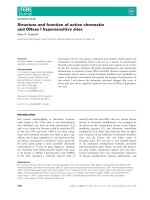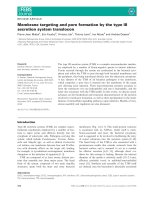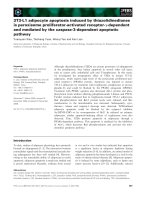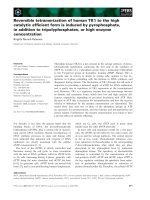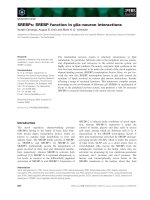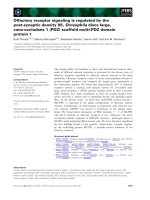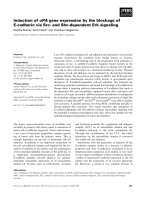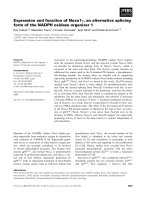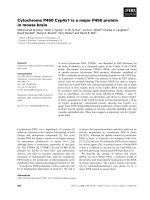Báo cáo khoa học: Androgen receptor function is modulated by the tissue-specific AR45 variant ppt
Bạn đang xem bản rút gọn của tài liệu. Xem và tải ngay bản đầy đủ của tài liệu tại đây (399 KB, 11 trang )
Androgen receptor function is modulated by the
tissue-specific AR45 variant
Isabelle Ahrens-Fath*, Oliver Politz, Christoph Geserick† and Bernard Haendler
Research Laboratories of Schering AG, Berlin, Germany
The surprising finding that the human genome only
codes for 20 000–25 000 genes suggests that several
processes contribute to additional complexity levels.
One such mechanism is the generation of multiple
RNA forms from a single gene through use of different
promoters or alternative splicing [1–3]. The correspond-
ing protein variants may exert very different and some-
times opposite biological functions [1–3]. Abnormal
splicing is responsible for about 50% of genetic disor-
ders [4], including some forms of Parkinson’s Disease,
of cystic fibrosis, of polycystic kidney disease and pro-
geria [5–8]. Changes in splicing patterns have also been
linked to cancer [9]; for example a role of the insulin
receptor, cyclin D1 and Mdm2 isotypes in tumour pro-
gression has been documented [10–12]. Consequently,
therapeutic modalities aiming at correcting abnormal
splicing events have already been envisaged [13].
Steroid receptors belong to a unique superfamily
of ligand-activated transcription factors that have
very pleiotropic effects [14]. They are organized in a
modular fashion and act by binding to DNA
response elements found in the regulatory regions of
their target genes [14]. Due to the involvement of
these receptors in several major diseases, extensive
research has been carried out to identify agonistic
and antagonistic ligands with beneficial effects. An
unresolved issue concerns the tissue- and cell-specific
activities observed with selective receptor modulators
[15–17]. Different panels of cofactors may account
for some of these effects [18]. Another possibility
arises from the existence of variant forms of steroid
receptors. The estrogen receptor (ER) probably
belongs to the most diversified family. Two isoforms,
ERa and ERb, exist, and have different tissue distri-
Keywords
androgen receptor; cofactor; heart; prostate
Correspondence
B. Haendler, CRBA Oncology, Schering AG,
D-13342 Berlin, Germany
Fax: +49 30 468 18069
Tel: +49 30 468 12669
E-mail:
Present address
*Paion Research Center, Berlin, Germany
†Spanish National Cancer Center, Madrid,
Spain
(Received 10 August 2004, revised 6
September 2004, accepted 9 September
2004)
doi:10.1111/j.1432-1033.2004.04395.x
A naturally occurring variant of the human androgen receptor (AR) named
AR45 has been identified. It lacks the entire region encoded by exon 1 of the
AR gene and is composed of the AR DNA-binding domain, hinge region
and ligand-binding domain, preceded by a novel seven amino-acid long
N-terminal extension. A survey of human tissues revealed that AR45 was
expressed mainly in heart and skeletal muscle. In cotransfection experiments,
AR45 inhibited AR function, an effect necessitating intact DNA- and
ligand-binding properties. Overexpression of AR45 reduced the proliferation
rate of the androgen-dependent LNCaP cells, in line with the repressive
effects of AR45 on AR growth-promoting function. AR45 interacted with
the AR N-terminal domain in two-hybrid assays, suggesting that AR inhibi-
tion was due to the formation of AR–AR45 heterodimers. Under conditions
where the transcriptional coactivator TIF2 or the oncogene b-catenin were
overexpressed, AR45 stimulated androgen-dependent promoters in presence
of dihydrotestosterone. AR45 activity was triggered additionally by the adre-
nal androgen androstenedione in presence of exogenous TIF2. Altogether,
the data suggest an important role of AR45 in modulating AR function and
add a novel level of complexity to the mode of action of androgens.
Abbreviations
AR, androgen receptor; DAPI, 4,6-diamidino-2-phenylindole; DBD, DNA-binding domain; DHT, dihydrotestosterone; ECL,
electrochemiluminescence; ER, estrogen receptor; FBS, fetal bovine serum; GFP, green fluorescent protein; LBD, ligand-binding domain;
MEM, minimal essential medium; NTD, N-terminal domain; PSA, prostate-specific antigen.
74 FEBS Journal 272 (2005) 74–84 ª 2004 FEBS
bution [15]. In addition, many ER splice variants
have been described, mainly in tumours [19]. The biolo-
gical function of ER variants has only been studied in a
few cases. Examples include ERa46, an ERa form lack-
ing the region encoded by the first exon, which modu-
lates the activity of ERa in MCF7 cells [20], and ERbcx,
a C-terminally truncated form containing 26 specific
amino acids, which forms heterodimers with ERa to
inhibit its function [21]. The progesterone receptor exists
as two isoforms, PRA and PRB, differing by the length
of the N-terminal end and originating from translation
reinitiation at an internal methionine codon. Studies
with transgenic mice show that the ratio of both forms
is essential for proper development of the mammary
gland [22]. Analysis of human endometrial tumours
indicates that loss of the B-form is linked to poor prog-
nosis [23]. Concerning the glucocorticoid receptor, a
splice variant named GRb that lacks the region encoded
by the most 3¢ exon and is unable to bind to glucocortic-
oids has been described. Overexpression of GRb leads
to glucocorticoid resistance in a number of pathological
conditions [24]. In the case of the mineralocorticoid
receptor a variant lacking the hinge and ligand-binding
regions but able to increase the activity of the full-length
receptor has been described [25].
Several variant forms of the androgen receptor (AR)
have been found. A short AR-A form arising, as for
PRA from internal translational reinitiation, has been
described [26]. Recent data, however, question its exist-
ence in human tissues [27]. A few cases of exon skip-
ping leading to androgen insensitivity have been
reported [28]. Finally, polymorphisms affecting the
length of glutamine, proline and glycine repeats exist
[28]. They may lead to severe pathologies, as observed
in Kennedy’s disease, a progressive motor neuron
degeneration caused by an extended polyglutamine
repeat in the N-terminal domain of the AR.
Here we describe the identification and characteriza-
tion of AR45, a human AR variant composed of a
unique N-terminal extension linked to the DNA-bind-
ing domain (DBD), hinge region and ligand-binding
domain (LBD) of the AR. The restricted expression
pattern, the inhibitory effect on AR function and the
cofactor-dependent activity suggest an important bio-
logical role of AR45 in modulating androgen action.
Results
Identification of AR45, a novel variant of the
human AR
5¢ Rapid amplification of cDNA ends (RACE) was
performed on human placental RNA using a reverse
primer directed against the hinge domain of the AR
and a forward primer recognizing the common 5¢ end
of the reverse-transcribed RNA. This allowed the
amplification of a 500 bp-long DNA fragment, much
shorter than the expected AR product. DNA sequen-
cing revealed that this fragment coded for the AR DBD
and hinge region preceded by a novel, short N-terminal
extension, rather than the 538 amino acid-long N-ter-
minal moiety encoded by exon 1 of the AR gene
(Fig. 1). A primer specific for the extreme 5¢ region was
then used together with a primer recognizing the 3¢ end
of the AR coding part to amplify the complete coding
region of this novel AR form. The deduced amino acid
sequence (Fig. 1A) revealed that it contained an intact
DBD, hinge region and LBD. However, it lacked the
entire region encoded by exon 1 of the AR which was
replaced by a short, unique seven amino acid-long
N-terminal extension. The deduced molecular mass was
about 45 kDa, hence the name AR45.
Homology search revealed that the AR45-specific
coding region was located on chromosome Xq11,
between exons 1 and 2 of the AR gene. The complete
DNA sequence of this novel exon, which we named
1B, together with flanking intron regions is depicted in
Fig. 1B. Exon 1B localized 22.1 kb downstream of
AR exon 1 (Fig. 1C) and was not predicted by annota-
A
B
C
Fig. 1. Sequence of AR45 and position of exon 1B in the AR gene.
(A) Deduced amino acid sequence of AR45. The unique N-terminal
extension is in bold. The exon limits are indicated with converging
arrowheads and the domain boundaries with colons. The residues
mutated for functional studies are underlined. (B) DNA and
deduced amino acid sequences of exon 1B. The open reading
frame is shown in bold capital letters. The flanking intron regions
are in italics. (C) Localization of exon 1B in the AR gene. Exon num-
bers are shown above the representation, intron sizes are given
below in kb. These sequence data have been submitted to the
DDBJ ⁄ EMBL ⁄ GenBank databases under accession number
AX453758.
I. Ahrens-Fath et al. Androgen receptor variant form
FEBS Journal 272 (2005) 74–84 ª 2004 FEBS 75
tion programs of the human genome. Its extremities
nevertheless conformed to the splicing rules.
AR45 is mainly expressed in heart
RT-PCR was carried out on a panel of human tissues
to determine the expression pattern of AR45 mRNA.
A primer corresponding to the AR45-specific upstream
region was used together with a primer recognizing the
AR common part. The strongest signal was observed
in heart, followed by skeletal muscle, uterus, prostate,
breast and lung. Weaker signals were seen in other tis-
sues, including testis (Fig. 2A). In comparison, very
low levels of the AR transcript were detected in heart,
as compared to liver or testis (Fig. 2B). The transcript
levels of the ribosomal S9 protein were determined as
a control (Fig. 2C). Initial studies with an antibody
directed against the AR LBD indicated that a band of
about 45 kDa was present in human heart extracts
(not shown). However, in the absence of an antibody
recognizing the specific N-terminal extension of AR45,
it cannot be excluded that this band corresponds to a
degradation product of the AR.
AR45 is bound by androgen and localizes
to the cell nucleus
The hormone-binding properties of AR45 were
assessed by competitive binding experiments in
presence of
3
H-labeled R1881 and increasing amounts
of cold R1881 (Fig. 3A) CV-1 cells were transfected
with a pSG5-based expression vector for AR45 or AR.
The results showed specific R1881 binding to AR45
with a calculated IC
50
of 22 nm. This was very close to
the IC
50
found for AR, which was 16 nm. When cor-
recting for the amount of AR45 or AR protein
expressed in the cells, as determined by Western blot
analysis and quantification of electrochemilumines-
cence (ECL) signals, comparable levels of total
[
3
H]R1881 bound to both forms were found (not
shown). The R243H mutant form of AR45 was used
as negative control. It corresponds to AR R774H, a
mutant unable to bind to androgens [29,30]. As expec-
ted, no specific binding was measured (not shown).
The subcellular localization of AR45 was deter-
mined by transfecting an expression vector coding for
AR45 with an N-terminally fused green fluorescent
brain
brain
testis
testis
liver
liver
prostate
prostate
lung
lung
trachea
trachea
muscle
muscle
breast
breast
heart
heart
kidney
kidney
uterus
brain
testis
liver
prostate
lung
trachea
muscle
breast
heart
kidney
uterus
uterus
AR45
S9
A
B
C
AR
Fig. 2. Analysis of tissue distribution of AR45 by RT-PCR analysis
of human RNA. First-strand cDNA from the indicated organs
was used as template for PCR amplification. Transcript levels of
(A) AR45, (B) AR and (C) ribosomal protein S9 (S9).
B
R1881 [M]
1e-10 1e-9 1e-8 1e-7 1e-6 1e-5 1e-4
cpm
0
5000
10000
15000
20000
25000
30000
35000
ARwt
AR45
A
Fig. 3. AR45 binds to androgen and localizes to the cell nucleus.
(A) CV-1 cells were seeded in six-well plates and transfected with
6 lg of expression plasmids for AR (d) or AR45 (m). For the bind-
ing test, the indicated concentrations of unlabeled R1881 were
mixed with the tracer. The radioactivity of whole cell extracts was
determined. The results are a representative of two separate
experiments. (B) Subcellular localization of AR45. Left panel: PC-3
cells were seeded in 24-well plates and transfected with 2.5 lgof
an AR45–GFP expression construct and treated with R1881. Fluor-
escence microscopy was used to visualize the chimeric AR45
protein. Right panel: nuclear staining with DAPI.
Androgen receptor variant form I. Ahrens-Fath et al.
76 FEBS Journal 272 (2005) 74–84 ª 2004 FEBS
protein (GFP) moiety into PC-3 cells. Following
R1881 treatment, we observed an exclusively nuclear
localization of AR45 (Fig. 3B, left panel). 4,6-Diami-
dino-2-phenylindole (DAPI) staining was performed
to visualize the cell nuclei (Fig. 3B, right panel).
Transfection of a control GFP plasmid gave fluores-
cent signals in both the cytoplasm and nucleus
(not shown).
AR45 inhibits AR transcriptional activity
Initial cell-based transactivation studies with different
cell lines and with constructs containing various andro-
gen-responsive promoters showed that AR45 did not
stimulate reporter gene activity in the presence or
absence of ligand (not shown). We therefore sought to
determine whether AR45 might be an inhibitor of AR
function. Transient transfection studies were performed
in CV-1 cells using AR45- and AR-expressing plas-
mids, in the presence of the MMTV-Luc reporter plas-
mid (Fig. 4A). Using increasing amounts of AR45
plasmid for transfection, a concentration-dependent
inhibition of androgen-stimulated AR activity was
observed. To find out whether androgen- and DNA-
binding were important for this effect, we devised
several mutant forms of AR45. AR45 R243H corres-
ponds to AR R774H, a mutant form not bound by
androgens [29,30]. Cotransfection experiments revealed
that the AR45 R243H mutant did not inhibit AR
function. AR45 C31G and DR84 correspond to AR
C562G and DR615, two mutants that no longer bind
to DNA [29,30]. These AR45 mutants also did not
repress AR activity in transactivation assays. Supris-
ingly, a stimulatory effect was elicited by all three
AR45 mutants at the highest plasmid concentration
used. To show that repression was not limited to a sin-
gle cell line, we performed similar cotransfection
experiments in the prostate cancer cell line PC-3 and
obtained comparable results (not shown).
The results were further confirmed with the prostate-
specific antigen (PSA) promoter (Fig. 4B). Here we
also observed an inhibitory effect of AR45 on AR
activity following overexpression in PC-3 cells. As
before, this was not seen with the mutant AR45
C31G, which does not bind to DNA.
The results show that AR45 acts as an inhibitor of
AR function. This may result from competition of
AR45 homodimers or of AR45–AR heterodimers with
AR homodimers for binding to DNA response ele-
ments.
0
500
1000
1500
2
000
2500
3000
3500
R.L.U.
0
2000
4000
6000
8000
10000
12000
14000
R.L.U.
0
2000
4000
6000
8000
10000
12000
14000
R. L. U.
0
2000
4000
6000
8000
10000
12000
14000
R
.
L
.
U
.
AR45
C31(562)G
R84(615)
R243(774)H
ng 0 25 50 100
ng 0 25 50 100 ng 0 25 50 100
ng 0 25 50 100
0
500
1000
1500
2000
2500
3000
0
500
1000
1500
2000
2500
AR45 C31(562)G
ng 0 25 50
ng 0 25 50
A
B
R.L.U.
R.
L. U.
Fig. 4. AR45 inhibits AR function. (A) CV-1
cells were transfected with a reporter vector
harbouring the MMTV promoter (40 ng), an
expression vector for AR (10 ng) and with
the indicated amounts (ng) of expression
plasmids for AR45 or a mutated form. Treat-
ment was with 1 n
M R1881 (grey bars) or
with vehicle (white bars). The results are a
representative of three separate experi-
ments and the bars are the mean ± SEM of
sextuplicate values. (B) PC-3 cells were
transfected with a reporter vector harbour-
ing the PSA promoter (40 ng), an expression
vector for AR (10 ng) and with the indicated
amounts (ng) of expression plasmids for
AR45 or a mutated form. Treatment was
with 1 n
M R1881 (grey bars) or with vehicle
(white bars). The results are a representa-
tive of three separate experiments and the
bars are the mean ± SEM of sextuplicate
values. Position of the mutations was indica-
ted relative to the AR45 amino sequence.
For clarity, the corresponding location in the
AR was also given in parentheses.
I. Ahrens-Fath et al. Androgen receptor variant form
FEBS Journal 272 (2005) 74–84 ª 2004 FEBS 77
AR45 inhibits proliferation of LNCaP cells
We next determined the biological effects of AR inhibi-
tion by AR45 in LNCaP cells. First, the endogenous
expression levels of AR45 mRNA were assessed in
LNCaP cells by RT-PCR, using similar conditions as
above. Specific AR45 transcripts were detected in
LNCaP cells grown in the presence or absence of
R1881 (Fig. 5A). When analyzing LNCaP nuclear
extracts with an antibody directed against the AR
LBD, several protein bands migrating ahead of full-
length AR were seen, including one of a size compat-
ible with that of AR45 (Fig. 5B, lane 4). Indeed, a pro-
tein band of similar size was also seen in PC-3 cells
transfected with an AR45-expressing plasmid (lane 2),
but not with an AR-expressing plasmid (lane 3). Also,
AR45 produced by an in vitro translation procedure
migrated at the same level (lane 1). Even though the
identity of the 45 kDa protein detected in LNCaP cells
was not demonstrated due to the unavailability of a
specific antibody, the results showed that AR45 expres-
sion was at best low.
Proliferation tests were carried out with LNCaP cells
grown in the presence of 0.1 or 1 nm R1881. Follow-
ing transfection of an AR45-expressing plasmid, a sig-
nificant reduction in the number of viable cells was
measured after three days at both hormone concentra-
tions, indicating that inhibition of cell proliferation
had taken place (Fig. 5C).
AR45 interacts with the N-terminal region
of the AR
Having determined that AR45 inhibited AR activity,
we sought to find out whether this was due to a direct
0
5000
10000
15000
20000
25000
30000
35000
0
500
1000
1500
2000
2500
AR45
AR NTD
+
+
+
+
+
+
A
B
AR45
AR NTD
R.L.U.
R.L.U.
Fig. 6. AR45 interacts with the AR NTD. CV-1 cells were seeded in
96-well plates and transfected with expression vectors for AR45
and for a fusion between the AR NTD and the activation domain of
NF-jB (40 ng each). Treatment was with 1 n
M R1881. (A) Reporter
plasmid (80 ng) containing the MMTV promoter was cotransfected.
(B) Reporter plasmid containing the Pem promoter (80 ng) was
cotransfected. The results are a representative of three separate
experiments and the bars are the mean ± SEM of sextuplicate
values.
R1881 (M) 0 10
-10
10
-9
128
42
85
AR45
B
AR
1234
0
200
400
600
800
1000
1200
1400
C
R.L.U.
A
AR45
AR
actin
12
Fig. 5. AR45 inhibits LNCaP cell proliferation. (A) Total RNA was
purified from LNCaP cells grown in the presence (lane 1) or
absence (lane 2) of 0.1 n
M R1881 and reverse-transcribed. Primers
specific for AR45 or AR were used for PCR amplification. The lev-
els of actin were determined as control. (B) Nuclear extracts were
prepared from LNCaP cells grown in presence of 1 n
M R1881 and
analyzed by Western blot using an antibody directed against the
LBD (lane 4). Nuclear extracts from PC-3 cells transfected with an
expression vector for AR45 or for AR were analysed in parallel
(lanes 2 and 3). In vitro translated AR45 was loaded on lane 1.
Molecular mass markers are indicated in kDa. (C) LNCaP cells
grown in presence of the indicated R1881 concentrations were
seeded in 10-cm Petri dishes and transfected with 20 lgofan
AR45-expressing vector. The number of viable cells was measured
after 3 days by quantifying the ATP levels (grey bars). In the control
experiment empty pSG5 plasmid was used (white bars). The
results are a representative of two separate experiments and the
bars are the mean ± SEM of quadruplicate values.
Androgen receptor variant form I. Ahrens-Fath et al.
78 FEBS Journal 272 (2005) 74–84 ª 2004 FEBS
interaction by performing a mammalian two-hybrid
assay. Expression vectors coding for full-length AR45
and for a fusion protein between various domains of
the AR N-terminal domain (NTD) and the activation
domain of NF-jB were cotransfected into CV-1 cells.
Using an MMTV reporter construct we observed a
strong, androgen-dependent interaction between AR45
and the AR NTD (Fig. 6A). No interaction was
observed between AR45 and the DBD, hinge region or
LBD of the AR (not shown). Additional experiments
were performed with a reporter construct harbouring
the androgen-dependent Pem promoter [31]. The
Pem gene codes for a homeobox protein of the paired-
like family involved in male reproductive functions [32]
and its promoter has recenly been shown to contain
highly selective androgen-responsive elements [31,33].
By performing similar two-hybrid assays, we also
observed an androgen–dependent interaction between
AR45 and the AR NTD (Fig. 6B) but not with other
regions of the AR (not shown).
These results indicate that AR45 binds to androgen-
responsive promoters and directly interacts with the
AR NTD.
AR45 stimulates androgen-dependent promoters
in presence of cofactors and adrenal androgen
The absence of stimulatory activity of AR45 might be
linked to poor coactivator recruitment, due to the
absence of the NTD. This might be overcome by the
overexpression of cofactors. To test this hypothesis, we
analyzed the effects of two AR cofactors known to
interact with the AR LBD. TIF2 and AR45 were over-
expressed in CV-1 cells (Fig. 7A). Subsequent dihy-
drotestosterone (DHT) treatment led to a sevenfold
increase of MMTV-driven reporter activity. When
coexpressing the oncoprotein, b-catenin, a fourfold
stimulation was seen (Fig. 7A). A similar induction
was also seen when using the S33F b-catenin mutant,
a form with enhanced stability previously identified
in several tumours, including prostate carcinoma
(Fig. 7A). There was no significant effect of AR45 and
cofactor overexpression on reporter gene activity in the
absence of DHT (not shown). To rule out that the
observed AR45 activity was cell- or promoter-specific,
we coexpressed AR45 and TIF2 in PC-3 cells, and
used the PSA promoter as well as the MMTV promo-
ter in the reporter plasmids. In these cells, TIF2 over-
expression enhanced DHT-dependent AR45 activity
sixfold on the MMTV promoter and twofold on the
PSA promoter (Fig. 7B,C). In the absence of DHT, no
significant difference was noted for MMTV or PSA
promoter activity following AR45 and TIF2 over-
A
B
C
D
Fig. 7. Activation of AR45 by cofactors and androstenedione. Trans-
fections were carried out in 96-well plates in presence of 30 ng of
AR45 plasmid, 120 ng of cofactor plasmid and 40 ng of reporter
plasmid. (A) CV-1 cells were transfected with expression vectors
for AR45 and for the indicated cofactors. A reporter construct con-
taining the MMTV promoter was cotransfected. Treatment was
with 1 n
M DHT (grey bars) or with vehicle (white bar). (B) PC-3 cells
were transfected with expression vectors for AR45 and TIF2. A
reporter construct containing the MMTV promoter was cotransfect-
ed. Treatment was with 1 n
M DHT (grey bars) or with vehicle
(white bar). (C) PC-3 cells were transfected with expression vectors
for AR45 and TIF2. A reporter construct containing the PSA promo-
ter was cotransfected. Treatment was with 1 n
M DHT (grey bars)
or with vehicle (white bar). (D) PC-3 cells were transfected with
expression vectors for AR45 and TIF2. A reporter construct contain-
ing the MMTV promoter was cotransfected. Treatment was with
1n
M androstenedione (grey bars) or with vehicle (white bar). The
results are a representative of two separate experiments and the
bars are the mean ± SEM of sextuplicate values.
I. Ahrens-Fath et al. Androgen receptor variant form
FEBS Journal 272 (2005) 74–84 ª 2004 FEBS 79
expression (not shown). Finally we tested the effects of
androstenedione on AR45 function. This hormone is
synthesized primarily by the adrenal glands and is not
suppressed by chemical castration used to treat pros-
tate cancer patients, which led to speculations about a
role in refractory tumours [27]. TIF2 and AR45 were
overexpressed in PC-3 cells. Following androstenedi-
one treatment, we measured a twofold stimulation of
the MMTV promoter (Fig. 7D).
Altogether these data document that under condi-
tions where coactivators are overexpressed, a stimula-
tion of AR45 by androgens such as DHT or
androstenedione may be observed.
Discussion
Here we report the cloning and characterization of
human AR45 cDNA, which codes for a variant form
of the AR. AR45 lacks the entire region encoded by
exon 1 of the AR gene and possesses instead a unique
seven amino acid-long stretch. This AR45-specific
region is entirely encoded by a hitherto undescribed
exon 1B lying between the first and the second exon of
the AR gene. AR45 may therefore originate from tran-
scription controlled by a novel promoter region lying
upstream of exon 1B. Interestingly, the consensus
binding sequence CAAGTG for the heart-specific tran-
scription factor Nkx2.5 [34] and motifs with 90% iden-
tity to the binding site GGGRNNYCCC for p65, a
subunit of the NF-jB transcription factor that regu-
lates gene expression in heart [35], are found in the
region immediately upstream of exon 1B (not shown).
Detailed studies are now needed to determine whether
this region directs heart-selective expression of AR45.
An alternative splicing event is less likely, because
no sequence corresponding to an additional, more
upstream exon was found in our 5¢ RACE-PCR
experiments. Nonetheless this cannot entirely be ruled
out and tissue-specific splicing mechanisms have
already been described for other steroid receptors
[36,37].
The role of androgens in the heart has been docu-
mented by many studies. Hypertension and myocardial
ischemia are associated with elevated androgen levels
[38]. Direct modulatory effects of androgens and estro-
gens on the left-ventricular mass have been postulated
[39]. Due to the comparatively low levels of AR in
heart, AR45 may play an important regulatory role, as
an inhibitor of AR function or possibly also as an acti-
vator in its own right, depending on the promoter con-
text and availability of cofactors. AR45 may act as a
dominant-negative inhibitor of AR function. As intact
ligand- and DNA-binding regions are mandatory for
this, the formation of AR45 homodimers and of
AR45–AR heterodimers on DNA response elements
may both account for the effect. The formation of
AR45–AR heterodimers is likely as previous experi-
ments with a truncated rat AR form lacking most of
the NTD have been shown to interact with full-length
AR in electrophoretic mobility shift assays [40,41]. If
such heterodimers cannot recruit the full coactivator
set needed for activity, dominant-negative effects may
be observed. The important role of the NTD, which
is absent in AR45, has been documented by several
studies [40–42]. The hormone-dependent interaction
between this region and the LBD of the AR is essen-
tial for activity. Its disruption by introducing appropri-
ate mutations in the NTD or by overexpressing an
N-terminal AR peptide leads to the impairment of AR
function [43,44]. The amino- to carboxy-terminus inter-
action probably forms a platform for recruitment of
several important cofactors [45–47]. Chaperones (e.g.
Bag1L), cofactors (e.g. ARA160 and ART27) and
signaling effectors (e.g. Akt) have been reported to
bind to the AR NTD [48]. It is therefore likely that
AR45 functions mainly as a repressor of AR function.
Our cellular assays show, however, that in an envi-
ronment where a cofactor such as TIF2 or an onco-
protein such as b-catenin is overexpressed, AR45 may
stimulate the expression of androgen-dependent pro-
moters following DHT and also adrenal androgen
binding. This might have implications in the progres-
sion of prostate carcinoma, a disease in which andro-
gens and the AR play the main role [49–51]. Enhanced
TIF2 protein levels have been found in the majority of
recurrent prostate cancers [52]. Elevated transcript
levels of b-catenin, including mutant forms coding for
proteins with enhanced stability, have also been found
in prostate tumours [53]. In addition, a nuclear colo-
calization with the AR and a strictly ligand-dependent
interaction have been reported for b-catenin [54].
Enhanced TIF2 or b-catenin expression may therefore
lead to aberrant AR45 activity and the stimulation of
prostate tumour cell proliferation. Our additional find-
ing that androstenedione, a low-affinity adrenal andro-
gen, may stimulate AR45 when cofactors are
overexpressed, suggests a mechanism by which treat-
ment-refractory prostate tumours may bypass testo-
sterone deprivation. In the light of a recent study
demonstrating that the AR is a major player in both
early and late androgen-independent stages of prostate
cancer [50], a survey of AR45 levels in tumour resec-
tions (surgical removal of tissue) should help clarify
the role of this variant form in disease progression.
In conclusion, we have identified AR45, a naturally
occurring variant of the AR. It may either repress or
Androgen receptor variant form I. Ahrens-Fath et al.
80 FEBS Journal 272 (2005) 74–84 ª 2004 FEBS
stimulate AR activity, depending on the respective lev-
els of each protein and of cofactors such as TIF2 and
b-catenin. This study raises the possibility of a role of
AR45 in modulating androgen effects in heart, where
this form is most abundantly expressed, or in prostate
tumours, where aberrant expression of cofactors may
modify its activity.
Experimental procedures
Chemicals and plasmids
Methyltrienolone (R1881), dihydrotestosterone (DHT) and
androstenedione (4-androstene-3,17-dione) were from
Dupont NEN (Boston, MA, USA). RPMI 1640, minimal
essential medium (MEM), OPTI-MEM, streptomycin, peni-
cillin, geneticin and l-glutamine were obtained from Gibco
BRL Life Technologies (Eggenstein, Germany). Fetal
bovine serum (FBS) was from PAA (Pasching, Austria).
FuGene 6 was from Roche Molecular Biochemicals
(Mannheim, Germany). The oligonucleotides were pur-
chased from MWG Biotech (Ebersberg, Germany) or Roth
(Karlsruhe, Germany). Plasmids were from Stratagene
(pSG5, pCMV-BD; Amsterdam, the Netherlands), Invitro-
gen (pCR-TOPO II; Karlsruhe, Germany) or Promega
(pGL3-Basic, pGL3-Promoter; Mannheim, Germany).
Cloning procedures and site-directed
mutagenesis
Human placental RNA (1 lg; Stratagene) was reverse-tran-
scribed using the 5¢-SMART RACE kit (BD Bioscience
Clontech; Heidelberg, Germany) and used as the template
for PCR amplification. This was performed with the
Advantage-2 PCR kit (BD Bioscience Clontech) using a
reverse primer directed against the AR hinge region (5¢-CA
GATTACCAAGCTTCAGCTTCCG-3¢) and the forward
5¢-Smart II primer that binds to the common end of the
SMART cDNA population. Reaction conditions were: five
cycles of 5 s at 94 °C, 3 min at 72 °C; five cycles of 5 s at
94 °C, 10 s at 70 °C, 3 min at 72 °C; 27 cycles of 5 s at
94 °C, 10 s at 68 °C, 3 min at 72 °C. Following agarose gel
separation, a 500 bp-long DNA fragment was generated, as
visualized after gel electrophoresis. It was cloned into the
pCR-TOPO II plasmid and sequenced. The corresponding
full-length cDNA was amplified from placental DNA using
a forward primer derived from the specific 5¢ extremity and
a reverse primer recognizing the 3¢ end of the AR. This
allowed the amplification of 1200 bp-long fragment which
was purified on a gel, cloned and sequenced.
Cloning of TIF2 and b-catenin coding sequences was
carried out using primers flanking the coding region and
human universal cDNA (QUICK-Clone II, BD Bioscience
Clontech) as the template. PCR amplification was per-
formed with the Herculase enhanced DNA polymerase
(Stratagene). Following purification on an agarose gel, the
amplified DNA was cloned into pCR-TOPO II (Invitrogen)
and sequenced.
Site-directed mutagenesis of AR45 to generate the C31G,
DR84 and R243H forms, and of b-catenin to generate the
S33F form was performed with the QuickChange kit (Strat-
agene) using appropriate mutating oligonucleotides, follow-
ing the manufacturer’s instructions.
RT-PCR analysis of AR45 mRNA expression
AR45 RNA levels were determined by semiquantitative
RT-PCR. Total RNA from different human organs was
obtained from BD Bioscience Clontech. LNCaP total RNA
was purified using the RNeasy kit (Qiagen, Hilden, Ger-
many). Reverse-transcription was carried out using the
First-Strand cDNA kit (Stratagene) and semiquantitative
PCR analysis performed with the Advantage-2 kit (Strata-
gene). The following primers were used for AR45: 5¢-ACA
GGGAACCAGGGAAACGAATGCAGAGTGCTCCTGA
CATTGCCTGT-3¢ and 5¢-TCACTGGGTGTGGAAATA
GATGGGCTTGA-3¢. Reaction conditions were: five cycles
of 5 s at 94 °C, 3 min at 72 °C; five cycles of 5 s at 94 °C,
10 s at 70 °C, 3 min at 72 °C; 23 cycles of 5 s at 94 °C,
10 s at 68 °C, 3 min at 72 °C. The following primers were
used for AR, 5¢-GGGTGAGGATGGTTCTCCCC-3¢ and
5¢-CTGGACTCAGATGCTCC-3¢. The reaction conditions
were as above, except that the annealing temperatures were
54 °C for five cycles, 52 °C for five cycles and 50 °C for 27
cycles. The amplification products were separated on a 1%
(w ⁄ v) agarose gel and stained with 0.5 lgÆmL
)1
ethidium
bromide.
Western blot analysis
Following separation on precast 4–12% Bis ⁄ Tris gels
(NuPAGE Novex, Invitrogen), the proteins were trans-
ferred onto poly(vinylidene difluoride) membranes (Roche
Molecular Biochemicals). Incubation with the primary anti-
body AR C-19 (sc-815; Santa Cruz Biotechnology, Santa
Cruz, CA, USA) was for 12 h at 4 °C and at a 1 : 2000
dilution. For the secondary, peroxidase-labeled anti-rabbit
whole IgG (A-0545, Sigma-Aldrich, Munich, Germany),
incubation was for 1 h at room temperature and at a
1 : 5000 dilution. Detection was performed using the electro-
chemiluminescence (ECL) kit and ECL hyperfilms (Amer-
sham Pharmacia Biotech, Freiburg, Germany).
In vitro translation
AR45 cDNA cloned into the pCRII-TOPO plasmid (1 lg)
was in vitro-translated using the TNT T7 ⁄ SP6 Coupled
Reticulocyte Lysate system and the SP6 RNA polymerase,
I. Ahrens-Fath et al. Androgen receptor variant form
FEBS Journal 272 (2005) 74–84 ª 2004 FEBS 81
following the manufacturer’s instructions (Promega). The
reaction products were stored at )70 °C in small aliquots.
Cell culture and transfections
Cell lines were obtained from the German Collection of
Microorganisms and Cell Cultures (Braunschweig, Ger-
many), except the PC-3 ⁄ AR cells, a stable, AR-expressing
cell line derived from PC-3 cells. CV-1 cells were grown at
37 °Cina5%(v⁄ v) CO
2
atmosphere in MEM, 10% (v ⁄ v)
FBS, 100 UÆmL
)1
penicillin, 100 lgÆmL
)1
streptomycin,
4mml-glutamine. PC-3 cells were grown at 37 °Cin5%
(v ⁄ v) CO
2
in F-12K medium, 5% (v ⁄ v) FBS, 100 UÆmL
)1
penicillin, 100 lgÆ mL
)1
streptomycin, 2 mml-glutamine.
PC-3 ⁄ AR cells were grown at 37 °C in 4.5% (v ⁄ v) CO
2
in
RPMI 1640, 10% (v ⁄ v) FBS, 100 UÆmL
)1
penicillin,
100 lgÆmL
)1
streptomycin, 4 mml-glutamine, 600 lgÆmL
)1
geneticin. LNCaP cells were grown at 37 °Cin5%(v⁄ v)
CO
2
in RPMI 1640, 5% (v ⁄ v) FBS, 100 UÆmL
)1
penicillin,
100 lgÆmL
)1
streptomycin, 4 mml-glutamine, 0.1 nm
R1881.
For the transactivation assays, the CV-1 and PC-3 cells
were seeded in 96-well plates at a concentration of 10 000–
15 000 cells per 100 lL per well in medium supplemented
as above except that 5% (v ⁄ v) charcoal-stripped FBS was
used. Transfections were carried out 18–19 h later using
FuGene 6 in OPTI-MEM and 40 ng of reporter plasmid
based on pGL3-Basic. For LNCaP cells, seeding was in six-
well plates (5 · 10
5
cellsÆwell
)1
) for 22 h. Transfection was
with X-treme GENE (Roche Molecular Biochemicals) using
10 lg of reporter plasmid. Expression plasmids for AR45,
AR or cofactors were cotransfected as indicated. The
amount of transfected plasmids was kept constant by add-
ing the appropriate concentrations of pSG5 containing a
neutral insert. Induction was performed 5 h later by adding
1nm (CV-1 and PC-3 cells) or 2 nm R1881 (LNCaP cells).
Alternatively 1 nm androstenedione was used. Measurement
of luciferase activity was carried out after 18 h in a Lumi-
count luminometer, following the addition of 100 lLof
LucLite Plus reagent (both Packard, Dreieich, Germany).
The activity of a constitutively active luciferase vector was
determined in parallel to assess transfection efficiency. For
all points the average value of six wells treated in parallel
was taken. The experiments were repeated independently at
least three times.
For the androgen binding test, CV-1 cells were seeded in
six-well plates (2 · 10
5
cellsÆwell
)1
) and transfected 24 h
later with pSG5-AR45 or pSG5-AR (6 lgÆwell
)1
). A
mutant corresponding to the nonandrogen-binding form
R774H was used in the control experiment. The level of
AR45 or AR was determined by Western blot analysis as
above. Quantification of the ECL signal was performed in
a Kodak Image Station (Rochester, NY, USA).
For determination of the nuclear localization, PC-3
cells (1.25 · 10
5
cells in 0.5 mL) were seeded in 24-well
plates on glass coverslips, transfected with 2.5 lgofa
GFP-AR45 expression construct and treated 5 h later
with 1 nm R1881. After 24 h, the cells were fixed with
3.7% (v ⁄ v) formaldehyde and examined by fluorescence
microscopy at 507 nm. Alternatively, staining with DAPI
(Calbiochem, Bad Soden, Germany) was performed to
visualize the nuclei.
For the proliferation tests, 3 · 10
5
LNCaP cells were
seeded into 10-cm Petri dishes. Transfection was with 20 lg
of pSG5-AR45 plasmid in Lipofectamine 2000 (Invitrogen).
The number of viable cells was determined after 3 days in a
Lumicount luminometer (Packard) using the Cell Titer-Glo
assay (Promega).
The two-hybrid assay was performed in CV-1 cells in the
96-well format (10
4
cellsÆwell
)1
). Transfection was for 4 h
with FuGene reagent using 80 ng of reporter plasmid,
40 ng of pSG5-AR45 and 40 ng of a pCMV-BD-based
plasmid containing different domains of the human AR.
Treatment was with 1 nm R1881 and luciferase activity was
determined after 23 h.
Androgen-binding assay
For the binding test, 200 lL of tracer (0.86 lCi of
3
H-labe-
led R1881 per well, 83.5 CiÆmmol
)1
; NEN) mixed with
200 lL of different concentrations of cold R1881 were
added to transfected CV-1 cells for 2 h at 37 °C. The cells
were washed, lysed with low-salt buffer [2% (w ⁄ v) SDS,
10% (v ⁄ v) glycerol, 10 mm Tris ⁄ HCl pH 8] for 5 min,
transferred into scintillation tubes, supplemented with
3.5 mL of Atomlight scintillator liquid (PerkinElmer,
Rodgau-Ju
¨
gesheim, Germany) and incubated for 18 h in
the dark. Scintillation counting was performed in a 1500
Liquid Scintillation Analyzer (Packard).
Acknowledgements
We are indebted to Prof G. Stock and Dr U F. Habe-
nicht for continuous interest in this project. We thank
Prof W D. Schleuning and Dr K. Bosslet for support,
and Dr D. Zopf, Dr K. Barbulescu and Dr D. Mum-
berg for fruitful discussions. The expert technical
assistance of F. Knoth, I. Schu
¨
ttke and M. Wostrack
was much appreciated.
The PC-3⁄ AR cell line and the human AR cDNA
were obtained from Prof A. Cato (FZ Karlsruhe,
Germany), the PSA promoter construct from Prof J.
Trapman (Erasmus Medical Center, Rotterdam, the
Netherlands).
References
1 Modrek B & Lee C (2002) A genomic view of alterna-
tive splicing. Nat Genet 30, 13–19.
Androgen receptor variant form I. Ahrens-Fath et al.
82 FEBS Journal 272 (2005) 74–84 ª 2004 FEBS
2 Roberts GC & Smith CW (2002) Alternative splicing:
combinatorial output from the genome. Curr Opin
Chem Biol 6, 375–383.
3 Stamm S (2002) Signals and their transduction path-
ways regulating alternative splicing: a new dimension of
the human genome. Hum Mol Genet 11, 2409–2416.
4 Sazani P & Kole R (2003) Therapeutic potential of
antisense oligonucleotides as modulators of alternative
splicing. J Clin Invest 112, 481–486.
5 Buee L, Bussiere T, Buee-Scherrer V, Delacourte A &
Hof PR (2000) Tau protein isoforms, phosphorylation
and role in neurodegenerative disorders. Brain Res Brain
Res Rev 33, 95–130.
6 Tsui LC (1992) The spectrum of cystic fibrosis muta-
tions. Trends Genet 8, 392–398.
7 Reynolds DM, Hayashi T, Cai Y, Veldhuisen B,
Watnick TJ, Lens XM, Mochizuki T, Qian F, Maeda
Y, Li L, et al. (1999) Aberrant splicing in the PKD2
gene as a cause of polycystic kidney disease. J Am Soc
Nephrol 10, 2342–2351.
8 Eriksson M, Brown WT, Gordon LB, Glynn MW,
Singer J, Scott L, Erdos MR, Robbins CM, Moses TY,
Berglund P, et al. (2003) Recurrent de novo point muta-
tions in lamin A cause Hutchinson–Gilford progeria
syndrome. Nature 423, 293–298.
9 Xu Q & Lee C (2003) Discovery of novel splice forms
and functional analysis of cancer-specific alternative
splicing in human expressed sequences. Nucleic Acids
Res 31, 5635–5643.
10 Denley A, Wallace JC, Cosgrove LJ & Forbes BE
(2003) The insulin receptor isoform exon 11-(IR-A) in
cancer and other diseases: a review. Horm Metab Res
35, 778–785.
11 Fridman JS, Hernando E, Hemann MT, de Stanchina
E, Cordon-Cardo C & Lowe SW (2003) Tumor pro-
motion by Mdm2 splice variants unable to bind p53.
Cancer Res 63, 5703–5706.
12 Lu F, Gladden AB & Diehl JA (2003) An alternatively
spliced cyclin D1 isoform, cyclin D1b, is a nuclear onco-
gene. Cancer Res 63, 7056–7061.
13 Mercatante DR, Sazani P & Kole R (2001) Modifica-
tion of alternative splicing by antisense oligonucleotides
as a potential chemotherapy for cancer and other dis-
eases. Curr Cancer Drug Targets 1, 211–230.
14 Mangelsdorf DJ, Thummel C, Beato M, Herrlich P,
Schutz G, Umesono K, Blumberg B, Kastner P, Mark
M, Chambon P et al. (1995) The nuclear receptor super-
family: the second decade. Cell 83, 835–839.
15 Nilsson S & Gustafsson JA (2002) Estrogen receptor
action. Crit Rev. Eukaryot Gene Expr 12, 237–257.
16 Negro-Vilar A (1999) Selective androgen receptor mod-
ulators (SARMs): a novel approach to androgen ther-
apy for the new millennium. J Clin Endocrinol Metab
84, 3459–3462.
17 Olive DL (2002) Role of progesterone antagonists and
new selective progesterone receptor modulators in
reproductive health. Obstet Gynecol Surv 57, S55–S63.
18 McKenna NJ, Lanz RB & O’Malley BW (1999) Nuclear
receptor coregulators: cellular and molecular biology.
Endocr Rev 20, 321–344.
19 Hopp TA & Fuqua SA (1998) Estrogen receptor var-
iants. J Mammary Gland Biol Neoplasia 3, 73–83.
20 Flouriot G, Brand H, Denger S, Metivier R., Kos M,
Reid G, Sonntag-Buck V & Gannon F (2000) Identifica-
tion of a new isoform of the human estrogen receptor-
alpha (hER-alpha) that is encoded by distinct tran-
scripts and that is able to repress hER-alpha activation
function 1. EMBO J 19, 4688–4700.
21 Ogawa S, Inoue S, Watanabe T, Orimo A, Hosoi T,
Ouchi Y & Muramatsu M (1998) Molecular cloning
and characterization of human estrogen receptor betacx:
a potential inhibitor of estrogen action in human.
Nucleic Acids Res 26, 3505–3512.
22 Mulac-Jericevic B, Lydon JP, DeMayo FJ & Conneely
OM (2003) Defective mammary gland morphogenesis in
mice lacking the progesterone receptor B isoform. Proc
Natl Acad Sci USA 100, 9744–9749.
23 Dai D, Wolf DM, Litman ES, White MJ & Leslie KK
(2002) Progesterone inhibits human endometrial cancer
cell growth and invasiveness: down-regulation of cellular
adhesion molecules through progesterone B receptors.
Cancer Res 62, 881–886.
24 Yudt MR, Jewell CM, Bienstock RJ & Cidlowski JA
(2003) Molecular origins for the dominant negative
function of human glucocorticoid receptor beta. Mol
Cell Biol 23, 4319–4330.
25 Zennaro MC, Souque A, Viengchareun S, Poisson E &
Lombes M (2001) A new human MR splice variant is a
ligand-independent transactivator modulating cortico-
steroid action. Mol Endocrinol 15, 1586–1598.
26 Wilson CM & McPhaul MJ (1996) A and B-forms of
the androgen receptor are expressed in a variety of
human tissues. Mol Cell Endocrinol 120, 51–57.
27 Gregory CW, He B & Wilson EM (2001) The putative
androgen receptor-A form results from in vitro proteo-
lysis. J Mol Endocrinol 27, 309–319.
28 Brinkmann AO (2001) Molecular basis of androgen
insensitivity. Mol Cell Endocrinol 179, 105–109.
29 McPhaul MJ (2002) Androgen receptor mutations and
androgen insensitivity. Mol Cell Endocrinol 198, 61–67.
30 Quigley CA, De Bellis A, Marschke KB, el-Awady MK,
Wilson EM & French FS (1995) Androgen receptor
defects: historical, clinical, and molecular perspectives.
Endocr Rev 16, 271–321.
31 Barbulescu K, Geserick C, Schu
¨
ttke I, Schleuning WD
& Haendler B (2001) New androgen response elements
in the murine pem promoter mediate selective transacti-
vation. Mol Endocrinol 15, 1803–1816.
I. Ahrens-Fath et al. Androgen receptor variant form
FEBS Journal 272 (2005) 74–84 ª 2004 FEBS 83
32 Wayne CM, Sutton K & Wilkinson MF (2002) Expres-
sion of the pem homeobox gene in Sertoli cells increases
the frequency of adjacent germ cells with deoxyribo-
nucleic acid strand breaks. Endocrinology 143, 4875–
4885.
33 Geserick C, Meyer HA, Barbulescu K & Haendler B
(2003) Differential modulation of androgen receptor
action by deoxyribonucleic acid response elements. Mol
Endocrinol 17, 1738–1750.
34 Harvey RP, Lai D, Elliott D, Biben C, Solloway M,
Prall O, Stennard F, Schindeler A, Groves N, Lavulo L,
et al. (2002) Homeodomain factor Nkx2–5 in heart
development and disease. Cold Spring Harb Symp Quant
Biol 67, 107–114.
35 Valen G, Yan ZQ & Hansson GK (2001) Nuclear
factor kappa-B and the heart. J Am Coll Cardiol 38,
307–314.
36 Poola I (2003) Molecular assays to profile 10 estrogen
receptor beta isoform mRNA copy numbers in ovary,
breast, uterus, and bone tissues. Endocrine 22, 101–112.
37 Denger S, Reid G, Brand H, Kos M & Gannon F
(2001) Tissue-specific expression of human ERalpha and
ERbeta in the male. Mol Cell Endocrinol 178, 155–160.
38 Liu PY, Death AK & Handelsman DJ (2003) Andro-
gens and cardiovascular disease. Endocr Rev 24, 313–
340.
39 Hayward CS, Webb CM & Collins P (2001) Effect of
sex hormones on cardiac mass. Lancet 357, 1354–1356.
40 Ikonen T, Palvimo JJ & Janne OA (1998) Heterodimeri-
zation is mainly responsible for the dominant negative
activity of amino-terminally truncated rat androgen
receptor forms. FEBS Lett 430, 393–396.
41 Palvimo JJ, Kallio PJ, Ikonen T, Mehto M & Janne
OA (1993) Dominant negative regulation of trans-
activation by the rat androgen receptor: roles of the
N-terminal domain and heterodimer formation. Mol
Endocrinol 7, 1399–1407.
42 Jenster G, van der Korput HA, van Vroonhoven C, van
der Kwast TH, Trapman J & Brinkmann AO (1991)
Domains of the human androgen receptor involved in
steroid binding, transcriptional activation, and subcellu-
lar localization. Mol Endocrinol 5, 1396–1404.
43 Minamiguchi K, Kawada M, Ohba S, Takamoto K &
Ishizuka M (2004) Ectopic expression of the amino-
terminal peptide of androgen receptor leads to androgen
receptor dysfunction and inhibition of androgen
receptor-mediated prostate cancer growth. Mol Cell
Endocrinol 214, 175–187.
44 He B, Lee LW, Minges JT & Wilson EM (2002) Depen-
dence of selective gene activation on the androgen
receptor NH
2
- and COOH–terminal interaction. J Biol
Chem 277, 25631–25639.
45 Haendler B (2002) Androgen-selective gene regulation in
the prostate. Biomed Pharmacother 56, 78–83.
46 He B & Wilson EM (2002) The NH
2
-terminal and car-
boxyl–terminal interaction in the human androgen
receptor. Mol Genet Metab 75, 293–298.
47 He B, Bai S, Hnat AT, Kalman RI, Minges JT, Patter-
son C & Wilson EM (2004) An androgen receptor
NH
2
-terminal conserved motif interacts with the COOH
terminus of the Hsp70-interacting protein (CHIP).
J Biol Chem 279, 30643–30653.
48 Heinlein CA & Chang C (2002) Androgen receptor
(AR) coregulators: an overview. Endocr Rev 23, 175–
200.
49 Sommer A & Haendler B (2003) Androgen receptor and
prostate cancer: molecular aspects and gene expression
profiling. Curr Opin Drug Discov Devel 6, 702–711.
50 Chen CD, Welsbie DS, Tran C, Baek SH, Chen R.,
Vessella R., Rosenfeld MG & Sawyers CL (2004) Mole-
cular determinants of resistance to antiandrogen ther-
apy. Nat Med 10, 33–39.
51 Balk SP (2002) Androgen receptor as a target in andro-
gen-independent prostate cancer. Urology 60, 132–138;
discussion 138–9.
52 Gregory CW, He B, Johnson RT, Ford OH, Mohler
JL, French FS & Wilson EM (2001) A mechanism for
androgen receptor-mediated prostate cancer recurrence
after androgen deprivation therapy. Cancer Res 61,
4315–4319.
53 Chesire DR, Ewing CM, Sauvageot J, Bova GS &
Isaacs WB (2000) Detection and analysis of beta-catenin
mutations in prostate cancer. Prostate 45, 323–334.
54 Pawlowski JE, Ertel JR, Allen MP, Xu M, Butler C,
Wilson EM & Wierman ME (2002) Liganded androgen
receptor interaction with beta-catenin: nuclear co-locali-
zation and modulation of transcriptional activity in neu-
ronal cells. J Biol Chem 277, 20702–20710.
Androgen receptor variant form I. Ahrens-Fath et al.
84 FEBS Journal 272 (2005) 74–84 ª 2004 FEBS
